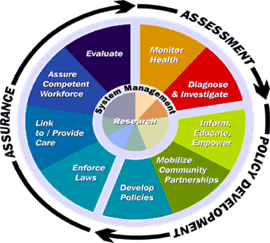The 10 essential public health services make up a schematic used by the National Public Health Performance Standards Program to evaluate the effectiveness of the essential public health service to the community. Public health systems must be able to demonstrate through health outcomes that they can provide the following ten essential public health services to those who use the health system’s resources in order to qualify as an effective public health system.
What Is a Public Health System
For the purposes of this schematic, a public health system is defined as any entity that contributes to the health of a given community, whether on a public, private, or voluntary basis. Depending on the community, this can include any organization that uses public health principles in public health agencies, public safety agencies; health care providers, including primary and specialty care, as well as urgent and emergent care; human service organizations; education and youth development programs; recreation organizations; mental health services; environmental groups; and others that contribute to helping the community have a fair and just opportunity by the removal of systemic and structural barriers to achieve optimal health for those who live within the bounds of the defined area. Having engaging health delivery systems in the community can influence health while mitigating emerging health threats.
How Were These Standards Developed
In 1988, the Institutes of Medicine released a report titled “The Future of Public Health”, that sought to establish a framework for public health leaders and public health professionals to reform future public health practices and influence and ensure effective public health practice at local, state, and national health departments. As a result, the Clinton administration developed a task force, that included representatives with public health expertise from Center for Disease Control and Prevention’s (CDC) Public Health Practice Program Office and the Office of Disease Prevention and Health Promotion, to establish these standards to help enable optimal public health. Their report establishing the 10 essential public health services “The Essential Services of Public Health”, was released in 1994. These standards were even further defined in 2002, when the CDC officially launched the National Public Health Performance Standards Program (NPHPSP). This program developed The State Public Health System Assessment, The Local Public Health System Assessment, and The Local Public Health Governance Assessment, which evaluates how well the entire public health system is using these standards.
What Are the 10 Essential Services of Public Health?
According to the Centers for Disease Control and Prevention, these 10 essential public health services fall into three key areas: assessment, assurance, and policy development.
The assessment standards include services for monitoring health status to identify and solve community problems with health, and diagnosing and investigating health issues and health hazards in the community.
The policy development standards include informing, educating, and empowering people about health issues; mobilizing community partnerships and action to identify and solve health issues and close health inequities; and developing policies and plans that support individual and community health efforts and close health disparities.
The assurance standards include:
- Enforcing laws and regulatory actions that protect health and ensure safety and equitable access.
- Linking people to needed personal health services and assure accessing needed health service and health care when otherwise unavailable.
- Assuring a competent public health workforce in the realm of health.
- Evaluating quality of personal and population-based health services and health education.
- Public health research involving new innovative solutions to health problems.
What is the job outlook for public health workers?
The U.S. Bureau of Labor Statistics reports robust growth in health professions in general. Check out BLS.gov for information of job and salary outlook for specific jobs in this important field. Future public health practitioners can check out the Occupational Outlook Handbook to help understand the job market in this field. Helping people as they are accessing needed health services as one in the public health workforce is a noble job that is very rewarding.
What is the professional organization for public health?
The organization for public health’s professional is the American Public Health Association (APHA). APHA’s vision to “Create the healthiest nation in one generation,” it champions the health of all people and all communities. APHA strives to strengthen the public health community and the profession of public health and speaks out for and promotes public health issues and policies. APHA is influential in federal agencies and federal policy and with it’s nearly 150-year history, and brings together members from all public health organizations and areas of public health to maximize their public health efforts and to innovate public health functions.
Conclusion
The 10 essential public health services help communities assess and improve the performance of their community health systems and provide public health solutions and help monitor population health status. Through public health communications and collaboration, the various entities involved in the overall health system can strengthen their existing community partnerships to provide the best health solutions and services to implement health improvement strategies and enable optimal health in the communities that they serve.
MPH staff, 2023
Additional Resources:
10 Most Affordable MPH Programs That Don’t Require GRE
Top 10 Best Epidemiology Programs-Master’s Degrees Online 2022
15 Best MPH Programs Not Requiring GRE 2022
10 Most Affordable MPH Degree Programs Online 2023
Top 10 Fastest MPH Degree Programs Online 2022